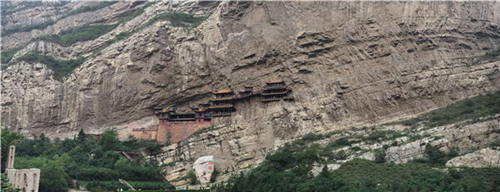

 |
|
Xuankong hanging temple at Hengshan Mountain in Shanxi is one of China's most stunning examples of ancient architecture. [Photo provided to China Daily] |
hanging temple at Hengshan Mountain in Shanxi is one of China's most stunning examples of ancient architecture. Sun Ruisheng and Li Yang reports
China has at least seven hanging temples, among which Xuankong Temple at Hengshan Mountain in North China's Shanxi province, is perhaps the most worthy of the title.
Built of wood, tiles and stones in the mid Northern Wei Dynasty (386-534), the temple is made up of two three-story pavilions and a yard linked by staircases and steps, which are lined along the surface of a sheer cliff 50 rising meters above the river at the foot of the mountain.
Seen from below, Xuankong Temple, which literally means "hanging in the sky", appears extremely precarious, supported only by a few thin stanchions standing on protruding rocks, that it was elected by Time magazine as one of the 10 most dangerous buildings in the world in 2010.
In fact, the stanchions were only added relatively recently as a psychological comfort to visitors, and it is the dozens of thick square beams made from hemlock wood soaked in tung oil to protect them from termites and rot that continue to sustain most of the buildings' weight.
There are many small holes left by the ancient builders, which they used to fasten their scaffolding to. Locals living near the mountain also dug a path along the slope of the cliff's surface to deliver construction materials.
A series of large, deep holes were dug into the cliff's surface, and two thirds of the length of the beam together with a wedge was driven into each one.
Geologically, the mountain is made up of parallel layers of solid limestone that incline slightly upward, among which is a layer of incompact sandstone. All the beam holes were dug into the same layer of limestone, which serves as a de facto platform after the sandstone around it was removed to allow space for the buildings.
Well-proportioned and cleverly arranged, the two pavilions, one higher than the other, perch above the yard along the gradient of the rock texture, which seems to inlay the buildings seamlessly into the cliff, making the temple an integrated part of nature.
The weathering of the wood and tiles over the centuries has narrowed the color differences between the rocks and the buildings. The compatibility between the buildings and the mountain makes the temple an architectural marvel.
There are other explanations as to why the temple has remained intact for more than 1,500 years. Other than its sturdy construction, local people have found that the section of cliff above the temple extrudes, acting like an umbrella shielding the complex from the rain and sunshine. In summer, when the daytime is the longest, the temple only receives about two hours of direct sunlight a day during the morning.
The narrow valley it faces also changes the direction of airflow. The wind usually blows toward the cliff facing the temple, but it rarely reaches the temple. And even during the most serious flooding of the river below, the water remains far beneath the foundations of the yard.
There used to be a Baima Temple built on a mountain opposite to the cliff where Xuankong Temple sits. It is believed the wind, sunshine and rain had accelerated the collapse of that temple long time ago. Its ruins can still be seen on the mountain slope.
That more than 80 holy statutes made of bronze, iron, stone and clay of Buddhism, Taoism and Confucianism are worshipped in the temple, which has a total of 40 rooms, shows North Wei Dynasty when it was build was inclusive to the coexistence of different religions.
The temple boasts of many carved beams and painted rafters, which tell stories and legends of the three kinds of religions. Although it is only 32 meters long and half a meter wide at the thinnest part, it has created an illusion to visitors as if it was a big temple, because of its rich ornaments and delicate layout design and space use.
Also, the time feels longer than usual when people creep gingerly on the wooden boards that seem teeter on the verge of collapse.
If you go
Xuankong Temple came under central government protection in 1982. It takes about two hours by bus or taxi to go to Hunyuan from Datong. It is suggested to arrive early in the morning in sunny days, if you want to see it in sunshine. To protect the constructions, limits are put on the number of tourists allowed at certain time. So avoid national holidays, as it takes one to two hours to queue to climb the mountain and reach the temple. Patients of heart diseases and high blood pressure are dissuaded from visiting the temple for safety concerns.